英语语言学 语域定义 中英文
(完整word版)语言学术语翻译及术语解释
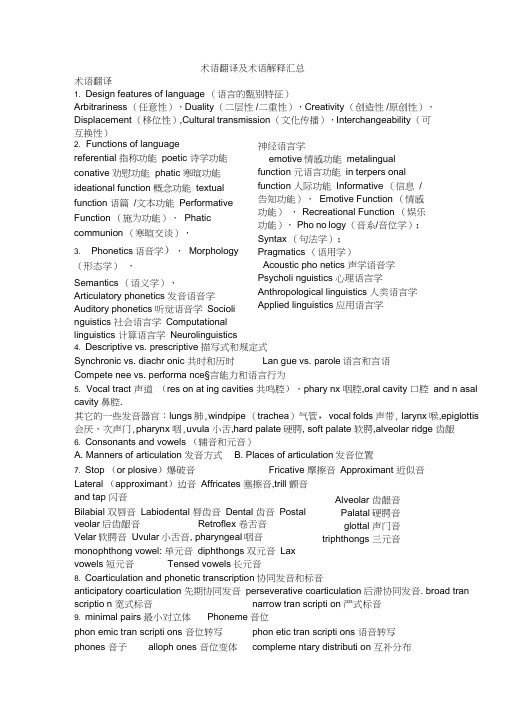
术语翻译及术语解释汇总术语翻译1. Design features of Ianguage (语言的甄别特征)Arbitrariness (任意性),Duality (二层性 /二重性),Creativity (创造性 /原创性), Displacement (移位性),Cultural transmission (文化传播),Interchangeability (可 互换性)2. Functions of language referential 指称功能 poetic 诗学功能 conative 劝慰功能 phatic 寒暄功能ideational function 概念功能 textualfunction 语篇 /文本功能 Performative Function (施为功能), Phatic communion (寒暄交谈), 3. Phonetics 语音学), Morphology (形态学) ,Semantics (语义学), Articulatory phonetics 发音语音学 Auditory phonetics 听觉语音学 Sociolinguistics 社会语言学 Computationallinguistics 计算语言学 Neurolinguistics神经语言学emotive 情感功能 metalingualfunction 元语言功能 in terpers onal function 人际功能 Informative (信息 /告知功能), Emotive Function (情感功能) , Recreational Function (娱乐功能), Pho no logy (音系/音位学); Syntax (句法学);Pragmatics (语用学)Acoustic pho netics 声学语音学 Psycholi nguistics 心理语言学 Anthropological linguistics 人类语言学 Applied linguistics 应用语言学4. Descriptive vs. prescriptive 描写式和规定式Synchronic vs. diachr onic 共时和历时 Lan gue vs. parole 语言和言语Compete nee vs. performa nce§言能力和语言行为5. Vocal tract 声道 (res on at ing cavities 共鸣腔),phary nx 咽腔,oral cavity 口腔 and n asal cavity 鼻腔.其它的一些发音器官:lungs 肺,windpipe (trachea )气管,vocal folds 声带, larynx 喉,epiglottis 会厌,次声门,pharynx 咽,uvula 小舌,hard palate 硬腭, soft palate 软腭,alveolar ridge 齿龈 6. Consonants and vowels (辅音和元音)A. Manners of articulation 发音方式B. Places of articulation 发音位置7. Stop (or plosive )爆破音 Fricative 摩擦音 Approximant 近似音Lateral (approximant )边音 Affricates 塞擦音,trill 颤音 and tap 闪音 Bilabial 双唇音 Labiodental 唇齿音 Dental 齿音 Postal veolar 后齿龈音 Retroflex 卷舌音 Velar 软腭音 Uvular 小舌音, pharyngeal 咽音monophthong vowel: 单元音 diphthongs 双元音 Laxvowels 短元音 Tensed vowels 长元音8. Coarticulation and phonetic transcription 协同发音和标音anticipatory coarticulation 先期协同发音 perseverative coarticulation 后滞协同发音. broad tran scriptio n 宽式标音 narrow tran scripti on 严式标音9. minimal pairs 最小对立体 Phoneme 音位phon emic tran scripti ons 音位转写phon etic tran scripti ons 语音转写 phones 音子 alloph ones 音位变体 compleme ntary distributi on 互补分布Alveolar 齿龈音Palatal 硬腭音glottal 声门音triphthongs 三元音phonetic similarity 发音近似性 Free variation 自 由变体assimilation 同化 regressive assimilation 逆同化progressive assimilatio n 顺同化 phono logical rule 音系规则 Epen thesis 增音binary 二分的Distinctive features 区别特征Endocentric and Exocentric Constructions 向心结构和离心结构subord in ate and coord in ate 从 属和并歹 U The refere ntial theory 指 称理论 Sema ntic tria ngle 语义三角Sense and referenee 涵义和指称Synonymy 同义关系 Antonymy 反义关系 Hyponymy 上下义关系Polysemy 一词多义关系 Homonymy 同音/形异意关系Dialectal synonyms 地域同义词 Stylistic synonyms 风格同义词 Collocati onal synonyms 搭配同义词gradable antonymy 等级反义关系 cover term 覆盖项Marked vs. unm arked terms 标记项和非标记项compleme ntary antonymy 互补反义关系 con verse antonymy 逆向反义关系homoph on es:同音异义词 homographs :同形异义词 complete homonyms sema ntic comp onents 语义部分术语解释1. Design feature 的定义:the defining (最典型的,起决定作用的) properties ofhuma n Ian guage that disti nguish it from any ani mal system of com muni cati on.2. Synchronic 共时:It refers to the description of a Ianguage at some point of time in history.3. Diachronic 历时:It studies the development or history of Ianguage. In other words, it refers tothe description of a Ianguage as it changes through time .4. prescriptive 规定式:A kind of linguistic s tudy aims to lay down rules for“ correctand standard ” behavior in using Ianguage 5. descriptive 描写式:A kind of linguistic study aims to describe and analyze the Ian guagepeople actually use6. Arbitrariness (任意性):By saying that “Ianguages arbitrary we,mean that there is no logicalconnection betwee n meaning and sound.7. Duality (二层性 /二重性):it means that Ianguage is a system, which consists of two levels of structures, at the lower level there is the structure of sounds; at the higher level there is the structure of meaning.8. Displaceme nt (移位性):it mean s that Ian guage can be used to com muni cate about thingsCon ceptual meaning^既念意义 Associative mea ning:联想意义 Conno tative mea ning 内涵意义 Affective meaning 情感意义 Collocative meaning 搭配意义 deno tati on:夕卜延意义Social meaning 社会意义 Reflected meaning 反射意义 Thematic meaning 主位意义 conno tati on:内涵that are not prese nt in our immediate com muni catio nal con text.9. compete nee 语言能力:it refers to an ideal speaker ' s kno wledge of the un derly ingsystem of rules in a Ian guage.10. Performance 语言行为: it refers to the actual use of the language by a speaker in a realcommunicational context.11. Langue 语言: it refers to the speaker 'usnderstanding and knowledge of the language that hespeaks.12. Parole 言语: it is the actual speaking of language by an individual speaker.13. Cultural transmission (文化传播):It refers to the fact that the details of the linguistic systemmust be learned ane(w 重新,再)by each speaker. Language is not transmitted biologically from generation to generation.14. Phatic communion (寒暄交谈):it refers to ritual exchanges, exchanges that have littlemeaning but help to maintain our relationships with other people.15. Pho netics(语音学):it is the study of the characteristics of speech soundsand providesmethods for their description, classification and transcription.16. Vowels 元音:the sounds in the production of which no articulators come very close togetherand the air-stream passes through the vocal tract without obstruction.17. Consonants 辅音:The sounds in the production of which there is an obstruction of theair-stream at some point of the vocal trac.t18. Phonology: it is the study of the sound systems of languages and it is concerned with thelinguistic patterning of sounds in human languages. And it studies the way in which speakers of a language systematically use a selection of these sounds in order to express meaning.19. Phoneme音位:the smallest unit of sound in a Ianguage which can distinguish two words.20. Allophone 音位变体: it refers to the different forms of a phoneme.21. Assimilation: it is a process by which one sound takes on some or all the characteristics of aneighboring sound.22. Coarticulation: a kind of phonetic process in which simultaneous or overlapping articulationsare involved.23. complementary distribution 互补分布: when two sounds never occur in the same environment,they are in complementary distribution.24. Free variation 自由变体: if two sounds occurring in the same environment do not contrast,that is, the substitution of one for the other does not produce a different word form, but merelya different pronunciation of the same word, then the two sounds are in free variation.25. Distinctive features 区别特征:A phonetic feature which distinguishes one phonological unit,especially one phoneme, from another.26. minimal pairs 最小对立体 --- which can be defined as pairs of words whichdiffer from each other by only one sound.27. vowel glides 滑音: The vowels involving movement from one sound to another are calledvowel glides.28. Epenthesis增音:it means a process of inserting a sound after another sound.29. Substitution relation: it refers to the relation specifically between an individual unit and othersthat can replace it in a given sequence.30. Endocentric construction is one whose distribution is functionally equivalent, or approachingequivalence, to one of its constituents, which serves as the centre, or head, of the whole.31. Exocentric construction: a group of syntactically related words where none of them isfunctionally equivalent to the group as a whole, that is, there is no definable center or head inside the group32. Reference: it is the relationship between words and the objects, actions or properties that thewords stand for. It deals with the extra-linguistic relationships betwee n words and expressi ons and the world they describe 具体的物质性的东西)33. Synonymy :It refers to the sameness sense relations between words.34. Componential analysis :Componential analysis defines the meaning of a lexical element interms of semantic components 语义部分.35. Sense:it refers to the complex system of relationships that hold between linguistic elementsthemselves, it is concerned only with intra-linguistic relations.(概念性的东西)36. Semantics:semantics is the study of the meaning of linguistic units, words and sentences inparticular.37. Homonymy: the phenomenon that words having different meanings have the same form, i.e.,different words are identical in sound or spelling, or in both.38. Antonymy :It refers to the oppositeness sense relations between words.39. Hyponymy 上下义关系:Hyponymy indicates sense inclusiveness. The upper term in thissenserelation is called superordinate 上义词, and the lower terms, hyponyms 下义词, members of the same class are callecdo-hyponyms.。
中英文对照英语语言学重要概念解析英语专业学生教师资格证考生

第一节语言的本质一、语言的普遍特征(Design Features)任意性Arbitratriness:shu 和Tree都能表示“树”这一概念;同样的声音,各国不同的表达方式双层结构Duality:语言由声音结构和意义结构组成(the structure of sounds and meaning)多产性productive: 语言可以理解并创造无限数量的新句子,是由双层结构造成的结果(Understand and create unlimited number with sentences)移位性Displacemennt:可以表达许多不在场的东西,如过去的经历、将来可能发生的事情,或者表达根本不存在的东西等文化传播性Cultural Transmission:语言需要后天在特定文化环境中掌握二、语言的功能(Functions of Language)1. 传达信息功能Informative:最主要功能The main function2. 人际功能Interpersonal:人类在社会中建立并维持各自地位的功能establish and maintain their identity3. 行事功能performative:现实应用——判刑、咒语、为船命名等Judge,naming,and curses4. 表情功能Emotive:表达强烈情感的语言,如感叹词/句exclamatory expressions5. 寒暄功能Phatic:应酬话phatic language,比如“吃了没?”“天儿真好啊!”等等6. 元语言功能Metalingual:用语言来谈论、改变语言本身,如book可以指现实中的书也可以用“book这个词来表达作为语言单位的“书”三、语言学的分支1. 核心语言学Core linguisticl 语音学Phonetics :关注语音的产生、传播和接受过程,着重考察人类语言中的单音。
语言学术语中英对照
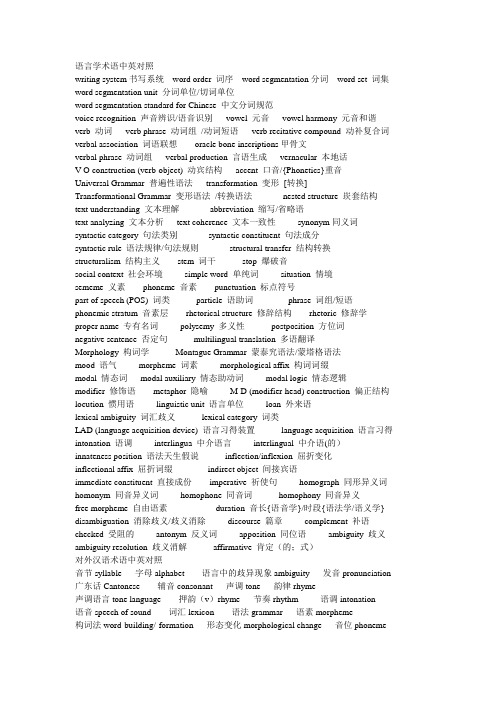
语言学术语中英对照writing system书写系统 word order 词序 word segmentation分词 word set 词集word segmentation unit 分词单位/切词单位word segmentation standard for Chinese 中文分词规范voice recognition 声音辨识/语音识别 vowel 元音 vowel harmony 元音和谐verb 动词verb phrase 动词组/动词短语 verb recitative compound 动补复合词verbal association 词语联想 oracle bone inscriptions甲骨文verbal phrase 动词组verbal production 言语生成vernacular 本地话V-O construction (verb-object) 动宾结构accent 口音/{Phonetics}重音Universal Grammar 普遍性语法transformation 变形[转换]Transformational Grammar 变形语法/转换语法nested structure 崁套结构text understanding 文本理解abbreviation 缩写/省略语text analyzing 文本分析 text coherence 文本一致性synonym同义词syntactic category 句法类别syntactic constituent 句法成分syntactic rule 语法规律/句法规则 structural transfer 结构转换structuralism 结构主义 stem 词干 stop 爆破音social context 社会环境 simple word 单纯词situation 情境sememe 义素 phoneme 音素 punctuation 标点符号part of speech (POS) 词类 particle 语助词 phrase 词组/短语phonemic stratum 音素层 rhetorical structure 修辞结构 rhetoric 修辞学proper name 专有名词polysemy 多义性 postposition 方位词negative sentence 否定句 multilingual translation 多语翻译Morphology 构词学 Montague Grammar 蒙泰究语法/蒙塔格语法mood 语气morpheme 词素 morphological affix 构词词缀modal 情态词 modal auxiliary 情态助动词 modal logic 情态逻辑modifier 修饰语 metaphor 隐喻M-D (modifier-head) construction 偏正结构locution 惯用语 linguistic unit 语言单位 loan 外来语lexical ambiguity 词汇歧义 lexical category 词类LAD (language acquisition device) 语言习得装置 language acquisition 语言习得intonation 语调interlingua 中介语言interlingual 中介语(的)innateness position 语法天生假说 inflection/inflexion 屈折变化inflectional affix 屈折词缀 indirect object 间接宾语immediate constituent 直接成份 imperative 祈使句 homograph 同形异义词homonym 同音异义词homophone 同音词 homophony 同音异义free morpheme 自由语素 duration 音长{语音学}/时段{语法学/语义学} disambiguation 消除歧义/歧义消除discourse 篇章 complement 补语checked 受阻的antonym 反义词apposition 同位语 ambiguity 歧义ambiguity resolution 歧义消解 affirmative 肯定(的;式)对外汉语术语中英对照音节syllable 字母alphabet 语言中的歧异现象ambiguity 发音pronunciation 广东话Cantonese 辅音consonant 声调tone 韵律rhyme声调语言tone language 押韵(v)rhyme 节奏rhythm 语调intonation语音speech of sound 词汇lexicon 语法grammar 语素morpheme构词法word-building/-formation 形态变化morphological change 音位phoneme声带vocal cords 发音器官organs of speech 呼吸器官respiratory organs音标phonetic alphabet 汉语拼音Chinese Phonetic Alphabet 属性attribute 发音articulation 甲骨文oracle bone inscriptions 笔画stroke 名词noun部首character component 表意文字ideograph 象形文字pictograph实词notional word 动词verb 形容词adjective 副词adverb代词pronoun 虚词function word 连词conjunction 语气词mood word 介词preposition 叹词interjection 助词auxiliary word 情态动词modal verb 主语subject 宾语object 定语attribute 补语complement谓语predicate 表语predicative 状语adverbial 修饰语modifier同义词synonym 反义词antonym 词组word group 时态tense专有名词proper noun 专业术语register 语境context 词尾ending后缀suffix 前缀infix 本义original meaning 基本义basic meaning引申义extended meaning 成语set phrase / idiom 方言dialect句法学Synt。
语言学重要概念梳理(中英文对照)
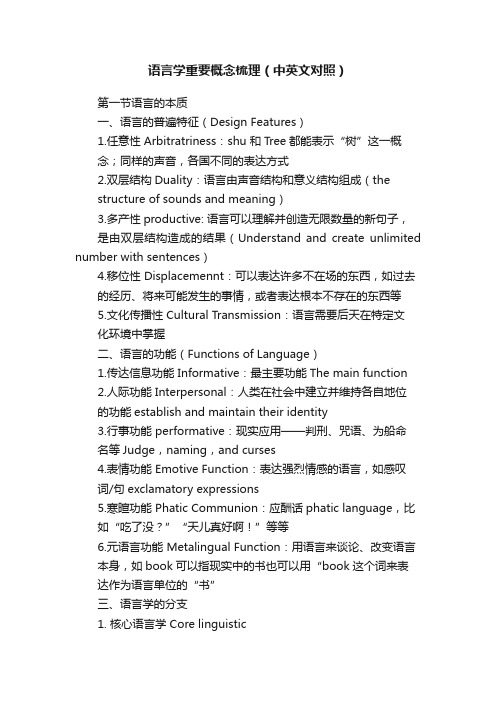
语言学重要概念梳理(中英文对照)第一节语言的本质一、语言的普遍特征(Design Features)1.任意性 Arbitratriness:shu 和Tree都能表示“树”这一概念;同样的声音,各国不同的表达方式2.双层结构Duality:语言由声音结构和意义结构组成(thestructure of sounds and meaning)3.多产性productive: 语言可以理解并创造无限数量的新句子,是由双层结构造成的结果(Understand and create unlimited number with sentences)4.移位性 Displacemennt:可以表达许多不在场的东西,如过去的经历、将来可能发生的事情,或者表达根本不存在的东西等5.文化传播性 Cultural Transmission:语言需要后天在特定文化环境中掌握二、语言的功能(Functions of Language)1.传达信息功能 Informative:最主要功能The main function2.人际功能 Interpersonal:人类在社会中建立并维持各自地位的功能establish and maintain their identity3.行事功能 performative:现实应用——判刑、咒语、为船命名等Judge,naming,and curses4.表情功能 Emotive Function:表达强烈情感的语言,如感叹词/句exclamatory expressions5.寒暄功能 Phatic Communion:应酬话phatic language,比如“吃了没?”“天儿真好啊!”等等6.元语言功能 Metalingual Function:用语言来谈论、改变语言本身,如book可以指现实中的书也可以用“book这个词来表达作为语言单位的“书”三、语言学的分支1. 核心语言学 Core linguistic1)语音学Phonetics:关注语音的产生、传播和接受过程,着重考察人类语言中的单音。
语言学术语英汉对照对照

back vowel
后元音
back-formation
逆构词法
bilabial
双唇音
bilingualism
双语(现象)
blending
拼缀法
borrowing
借用
bound morpheme
黏着词素
broad transcription
宽式标音
case
格
case condition
英汉术语对照
acoustic phonetics
声学语音学
acronym
首字母缩略词
acronymization
首字母缩略法
adjacency condition
毗邻条件
adjacency parameter
毗邻参数
adj-movement
形容词移位
affective meaning
情感意义
affix
词缀
affixation
词缀法
Afro-asiatic Family
亚非语系,闪含语系
agglutinative language
粘着语
allomorph
语素变体
allophone
音位变体
ambiguity
歧义(多义性)
arbitrariness
任意性
articulatory phonetics
发音语音学
成事性言语行为
person
人称
person deictics
人称指示词
pharyngeal cavity
咽腔
phone
音素
phoneme
音素
phoneme
语言学重要概念梳理中英文对照版
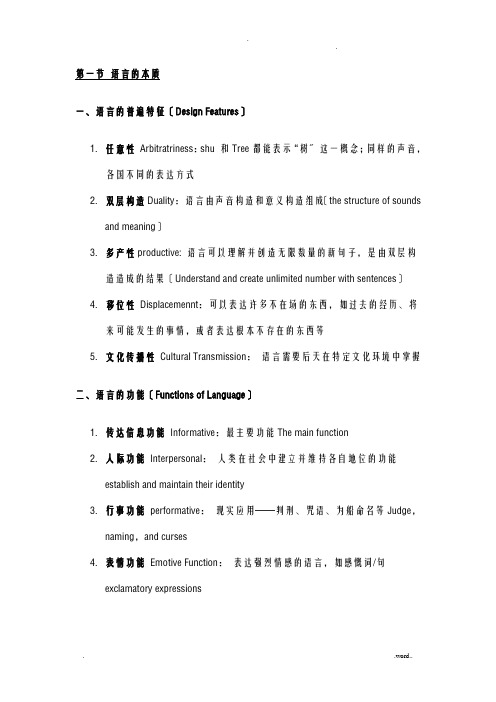
第一节语言的本质一、语言的普遍特征〔Design Features〕1.任意性Arbitratriness:shu 和Tree都能表示“树〞这一概念;同样的声音,各国不同的表达方式2.双层构造Duality:语言由声音构造和意义构造组成〔the structure of soundsand meaning〕3.多产性productive: 语言可以理解并创造无限数量的新句子,是由双层构造造成的结果〔Understand and create unlimited number with sentences〕4.移位性Displacemennt:可以表达许多不在场的东西,如过去的经历、将来可能发生的事情,或者表达根本不存在的东西等5.文化传播性Cultural Transmission:语言需要后天在特定文化环境中掌握二、语言的功能〔Functions of Language〕1.传达信息功能Informative:最主要功能The main function2.人际功能Interpersonal:人类在社会中建立并维持各自地位的功能establish and maintain their identity3.行事功能performative:现实应用——判刑、咒语、为船命名等Judge,naming,and curses4.表情功能Emotive Function:表达强烈情感的语言,如感慨词/句exclamatory expressions5.应酬功能Phatic munion:应酬话phatic language,比方“吃了没?〞“天儿真好啊!〞等等6.元语言功能Metalingual Function:用语言来谈论、改变语言本身,如book可以指现实中的书也可以用“book这个词来表达作为语言单位的“书〞三、语言学的分支1. 核心语言学Core linguistic1)语音学Phonetics:关注语音的产生、传播和承受过程,着重考察人类语言中的单音。
语言学专业词汇中英文对照版

语言学专业词汇中英文对照版语言学术语(英-汉对照)表applied linguistics 应用语言学blending 混成法A applied sociolinguistics 应用社会语borrowing 借用借词abbreviation 缩写词,略语言学bound morpheme 粘着语素ablative 夺格,离格appropriacy 适宜性bounding theory 管辖论accent 重音(符)appropriateness 适宜性得体性bracketing 括号法accusative 宾格approximant 无摩擦延续音brevity maxim 简洁准则achievement test 成绩测试aptitude test 素质测试bridging 架接acoustic phonetics 声学语音学Arabic 阿拉伯语broad transcription 宽式音标acquisition 习得arbitrariness 任意性broadening 词义扩大acronym 缩略语argument 中项中词主目Brown corpus 布朗语料库action process 动作过程article 冠词 Cactor 动作者articulation 发音calculability 可计算性address form 称呼形式articulator 发音器官calque 仿造仿造词语addressee 受话人articulatory phonetics 发音语音学cancellability 可删除addresser 发话人artificial speech 人工言语cardinal numeral 基数adjective 形容词aspect 体cardinal vowel 基本元音adjunct 修饰成分附加语aspirated 吐气送气case 格adverb 副词assimilation 同化case grammar 格语法affix 词缀associative 联想case theory 格理论affixation 词缀附加法associative meaning 联想意义category 范畴affricate 塞擦音assonance 准压韵半谐音categorical component 范畴成分agreement 一致关系attributive 属性修饰语定语causative 使役的使投动词airstream 气流auditory phonetics 听觉语音学center 中心词alliteration 头韵authentic input 真实投入central determiner 中心限定词allomorph 词/ 语素变体authorial style 权威风格chain relation 链状关系allophone 音位变体authoring program 编程chain system 链状系统allophonic variation 音位变体autonomy 自主性choice 选择allophony 音位变体现象auxiliary 助词choice system 选择系统alveolar ridge 齿龈auxiliary verb 助动词circumstance 环境因子alveolar 齿龈音 B class 词类ambiguity 歧义babbling stage 婴儿语阶段class shift 词性变换analogical creation 类推造字back-formation 逆构词法clause 小句从句anapest 抑抑扬格base component 基础部分click 吸气音咂音anaphor 前指替代behavioural process 行为过程clipping 截断法anaphoric reference 前指照应behaviourism 行为主义closed class 封闭类animate 有生命的bilabial 双唇音closed syllable 闭音节annotation 注解bilabial nasal 双唇鼻音cluster 音丛antecedent 先行词前在词bilateral opposition 双边对立coarticulation 协同发音anthropological linguistics 人类语bilingualism 双语现象coda 结尾音节符尾学binary division 二分法code 语码信码anticipatory coarticulation 逆化协同binary feature 二分特征cognitive psychology 认知心理学//X -^7- 发音binary taxonomy 二分分类学cognitive system 认知系统antonomasia 换称代类名binding 制约coherence 相关关联antonym 反义词binding theory 制约论cohension 衔接antonymy 反义(关系)blade 舌叶舌面前部co-hyponym 同下义词appellative 称谓性blank verse 无韵诗colligation 类连结collocative meaning 搭配意义 color word 色彩词 color word system 色彩词系统command 指令common core 共核common noun 普通名词communication 交际 communicative competence 交际能力communicative dynamism, CD 交际性动力communicative language teaching, CLT 交际语言教学法communicative Sentence Pattern, CSP 交际性句子模式communicative syllabus 交际教学大纲communicative test 交际性测试communicative-grammatical approach 交际-语法教学法compact disk 激光盘 comparative degree 比较级competence 能力complement 补语complementary antonym 互补反义词complementary antonymy 互补反义关系complementary distribution 互补分布complex predicate 复合谓语component 成分componential analysis 成分分析 composite proposition 复合命题compositionality 复合性 compound 复合词复合句 comprehension 理解computation 计算computational linguistics 计算语言学computational system 计算系统computer-assisted learning, CAL 计算机辅助学习computer corpus 计算机语料库computer hardware 计算机硬件 computer literacy 计算机操作能力 computer networks 计算机网络computer system 计算机系统computer-assisted instruction, CAI 计算机辅助教学computer-assisted learning,CALL 计算机辅助语言学习conative 意动的concept 概念conceptual meaning 概念意义concord 一致(关系) concordance 共现关系 concrete noun 具体名词 concurrent 同时发生的conjugation 词形变化 conjunct 连接副词conjunction 连接词conjunction buttressing 连接词支撑connotation 内涵consequent 跟随成分 consonance 辅音韵 consonant 辅音 constant opposition 不变对立constative 表述的 constituentcommand 成分指令 constituentproposition 成分命题 constituentstructure analysis 成分结构分析constituent 成分 construct 编制construct validity 编制效度construction 构建 constructivism构建主义 content analysis 内容分析content validity 内容效度 contentword 实义词 context dependent 语境依赖的 context of situation 情景语境 context 语境 contextualanalyses 语境分析 contextualmeaning 语境意义 contrastiveanalysis 对比分析 control theory控制理论 controlled language 有控制的语言 convention 常规规约conventional meaning 常规意义规约意义 conventionality 常规性规约性 conversational implicature 会话含义 conversational maxim 会话准则converse antonymy 相反反义现象conversion 变换 cooperativeprinciple, CP 合作原则 coordinateconstruction 并列结构 coordination 并列 coreferential 互参的 coronal舌面前音 corpus data 语料库语料corpus (pl corpora) 语料素材corpus linguistics 语料库语言学context 上下文 countable 可数(名词) counterfactual proposition 反事实命题 couplet 对句对联creativity 创造性原创性 Creole 克里澳尔语混和语 cross-cultural communication 跨文化交际 cross- linguistic 跨语言的 culturally- specific 文化特异的 curriculum 教学大纲 customizing 定制的 D dactyl 扬抑抑格 Dani language 达尼语 data retrieval, DR 资料检索 database 数据库 dative (case) 与格 dative movement 与格移动 declarative 陈述句 decoding 解码 deductive 演绎的deep structure 深层结构defeasibility 消除可行性 definite有定的 degenerate data 无用的语料deixis 指称 delicacy 精密阶denotation 外延指称 dental 齿音dentalization 齿音化 derivation 衍生 derivational affix 衍生词汇derivational morphology 派生形态学descriptive adequacy 描写充分性descriptive linguistics 描写语言学design feature 结构特征 determiner限定词 developing grammar 发展语法deviant 变体 deviation 偏离变异devoicing 清音化 diachronic linguistics 历时语言学 diachronic历时的 diacritic 附加符号变音符diagnostic test 诊断性测试 dialect方言 dialectology 方言学 digitized sound 数字化语音 dimetre 二音步诗行 diphthong 二合元音双元音direct object 直接宾语 direct speech, DS 直接言语 direct thought, DT 直接思想directionality 方向性 discourse 语篇话语 discourse analysis 语篇分析话语分析 discourse interpretation 语篇理解 discrete分离的离散的 discrete-point grammar 离散语法 discrete point test 分立性测试 disjunction 分离关系 displacement 移位 dissimilation 异化(作用) distinctive feature区别性特征 distinguisher 辩义成分do-insertion rule do 添加规则domain 范围领域 dorsal 舌背音舌中音 dorsum 舌背(音) double comparative 双重比较 drill-and- practice software 操练软件 D- structure D 结构 dual 双数dualistic view 二分观点 duality 二重性 E early Modern English 早期现代英语 economy 经济性简洁性ejective 爆发音 electronic mail 电子邮件 Elizabethan English 伊利莎白时期英语ellipsis 省略(法) ellipticalsentence structure 省略句子结构embedded element 嵌入成分emic 位学的 emotive 感情的 empirical 经验主义的 empirical data 经验主义的语料empirical validity 经验效度empiricism 经验主义empty category, EC 空范畴 enablingskills 使成技能化 encoding 编码end rhyme 末端韵endocentric construction 内向结构entailment 蕴涵entry condition 入列条件epenthesis 插音增音equipollent opposition 均等对立equivalence 相等equivalence reliability 相等信度 error analysis 错误分析 EST 科技英语 ethnicity identity 民族认同ethnography of communication 交际民族学 etic 非位的素的event process 事件过程example-based machine translation 基于例句的机器翻译 exchange error 交换错误exchange sequence 交际序列exchange structure 交际结构exhaustive 穷尽的彻底的 existent 存在物 existential 存在句existential process 存在过程existential quantifier 存在数量词exocentric 外向的 exocentric construction 外向结构 experiential 经验的 experiential function 经验功能experimental psycholinguistics 实验心理语言学explanatory adequacy 解释充分性explicit grammar instruction, EGI 明显的语法教学法expression minimization 表达最底程度expressive 表达的extended standard theory, EST 扩展标准理论extensive 引申的扩展的 extent-condition format 程度条件格式external evaluation 外部评估external qualifier 外部修饰语extrinsicsources of error 外在的错误来源eye movement 眼部移动Fface validity 卷面效度facilitation 便利促进Fasold feasibility 可行性 feature特征 feedback 反馈 felicitycondition 适宜性条件恰当条件feminine 阴性 fiction 小说figurative language 比喻性语言象征性语言figures of speech 修辞手段修辞格finite element 有定成分 finite 有定的有限的 finite state grammar有限状态语法first-person narrator 第一人称叙述者Firthian phonology 弗斯音系学 flap闪音flexibility 灵活性变通性 floppydisk 软盘 focus 焦点中心 folketymology 俗词源学民间词源foregrounded features 突出特征foregrounding 突出前景话 foreignlanguage teaching 外语教学 form形式 formal difference 形式差异formalization 形式化 formation 形成 formative 构形成分构词成分free form 自由形式 free indirectspeech, FIS 自由间接言语 freeindirect thought, FIT 自由间接思想 free morpheme 自由语素 free root morpheme 自由词根语素free variant 自由变体 free verse自由韵文 French 法语 frequency effect 频率效应 fricative (摩)擦音friction 摩擦 front 舌面前舌前的fully automatic high quality translation, FAHQT 全自动高质量翻译 function word 功能词 function 功能 functional grammar 功能语法functional linguistics 功能语言学functional sentence perspective, FSP 功能句子观 functions of language 语言功能 fusion 溶合fuzzy 模糊的 G gender difference 性别差异 general linguistics 普通语言学 generalisation 概括generative grammar 生成语法generative semantics 生成语言学genitive 属格所有格 genre 体裁语类 German 德语 given (information) 已给信息 global task 整体任务glottal 喉音glottal stop 喉塞音 goal 目标government theory 支配理论government 支配 grammatical analysis 语法分析 grammatical function ; ; grammatical structure 语法结构 gradable antonymy 分等级的反义关系gradual opposition 渐次对立grammatical category 语法范畴grammatical concept 语法概念grammatical description 语法描写grammatical form 语法形式grammatical marker 语法标记grammatical meaning 语法意义grammatical organization 语法组成 grammatical pattern 语法类型grammatical process 语法过程grammatical rule 语法规则grammatical sentence pattern, GSP 语法句形 grammatical structure 语法结构 grammatical subject 语法主语 grammatical system 语法系统grammatical word 语法词 graphitic form 文字形式 Gricean maxim Grice 准则 group 词组 guttural 腭音H half-rhyme 半韵 hard palate 硬腭head 中心词中心成分 headed construction 中心结构 heptameter 七音步诗行 hierarchical structure 等级结构 hierarchical system 等级系统 hierarchy 等级体系 high 高(元音) historical linguistics 历史语言学 holophrastic stage 单词句阶段homonym 同音 / 形异议词Hopi Hopi 语 horizontal relation链状关系 Horn scale 霍恩阶 humancognitive system 人类认知系统human language 人类语言 humanspeech 人类言语 human translation 人译 hypercorrection 矫枉过正hyponym 下义词hyponymy 下义关系hypothesis 假设hypothesis-deduction 假设 -演绎 I iamb 抑扬格iambic pentameter 抑扬格五音步诗行IC analysis 直接成分分析法 ICALL (intelligent CALL) 智能计算机辅助语言学习ideational (function) 概念功台匕能identifying 认同的 idiom 成语习语idiomatically-governed 习语支配的ill-formed sentences 不合适的句子illocutionary act 话中行为施为性行为illocutionary force 言外作用施为作用imaginative (function) 想象功能immediacy assumption 即时假定immediate constituent analysis 直接成分分析法imperative rule 祈使规则imperative 祈使语气命令的implicate 意含 implication 蕴涵含义 implication connective 蕴涵连接implicature 含义言外之意implied meaning 蕴涵意义implosive 内破裂音内爆音inanimate 无生命的inclusiveness relation 内包意义indefinite 不定的,无定的indicative 陈述式陈述语气indirect object 间接宾语indirct speech, IS 间接言语indirect thought, IT 间接思想 Indo-European languages 印欧语言inference 推论推理inference drawing 推论inferential communication 推论交际infinitive 不定式infix 中缀inflection 屈折(变化) inflectional affix 屈折词缀inflectional morphology 屈折形态学inflective endings 屈折结尾information retrieval 信息检索information structure 信息结构informative (function) 信息功台匕能innateness 先天性innateness hypothesis (语法)天赋假设 input 输入input hypothesis 语言输入说instrumental (function) 工具功台匕能integrative test 综合性测试intensifier 强调成分 intensive 强调的增强的 interactional(function) 交互功台匕能interdental 齿间音 interface 界面interference 干扰 interjection 感叹词 interlanguage 中介语interlingua 国际语 interlingualapproach 语际法 interlocutor 会话者 internal evaluation 内部评估internal structure 内部结构international phonetic alphabet,IPA 国际音标internet 互联网 interpersonal 人际的 interpersonal function 人际功台匕能interpretation 解释 interrogative sentence 疑问句 intonation 语调intra-linguistic relation 语言内关系 intransitive 不及物的 intrinsic sources of error 错误的内源invariable word 不变词 invention新创词语 inversion 倒置,倒装 IPA chart 国际音标图 IPS symbol 国际音标符号 irony 讽刺反话 isolated opposition 孤立对立 Italian 意大利语 JJapanese 日语 jargon 黑话行语Jesperson, Otto Johnson & Johnson JohnsonJones, DanielKkernel sentence 核心句 keyword 关键词 knowledge 知识 known information 已知信息 Krashen Kruszewski, Mikolaj Kuno, Susumo L label 标示标记 labial 唇音labiodental 唇齿音 language 语言language acquisition device, LAD 语言习得机制language attitude 语言态度language choice 语言选择 language comprehension 语言理解language data 语言素材 language learning 语言学习 language maintenance 语言维护 language processing 语言处理 language structure 语言结构 language system 语言系统 language teaching 语言教学language universal 语言普遍性language use 语言使用 langue 语言(系统) larynx 喉头 lateral 边音旁流音Latin 拉丁语Latin grammar 拉丁语法 lax vowel 松元音 length 长度音长 letter 字母 level 层,级,平面 Levinson, Stephen lexeme 词位词素 lexical ambiguity 词汇歧义 lexical change 词汇变化 lexical level 词汇层lexical meaning 词汇意义 lexical morphology 词汇形态学 lexical studies 词汇研究 lexical word 词汇词 lexicogrammar 词汇语法 lexicon 词汇词典 lexis 词 liaison 连音连续 limerick 打油诗 line 诗行linear phonology 线性音系学 linear structure 线形结构 linguistic university 语言普遍性 linguistic behaviour 语言行为 linguistic behaviour potential 语言行为潜势linguistic competence 语言能力linguistic context 语言语境上下文linguistic data 语言素材linguistic description 语言描写linguistic determinism 语言决定论linguistic facts 语言事实linguistic relativity 语言相对性linguistic sexism 语言性别歧视linguistic structure 语言结构linguistic theory 语言理论linguistic unit 语言单位linguistic universal 语言普遍性linguistic variation 语言变异linguistics 语言学 lip rounding 圆唇化 literal language 本义语言literary stylistics 文学文体学loan translation 翻译借词loanblend 混合借词loanshift 转移借词loanword 借词local area networks, LAN 局域网 locutionary act 发话行为,表述性言语行为logical component 逻辑成分logical connective 逻辑连词logical form component 逻辑式成分logical form representation 逻辑式表达logical formula 逻辑公式logical function 逻辑功能logical semantics 逻辑语义学 logical structure 逻辑结构 logical subject 逻辑主语 logophoricity 词照应London School 伦敦学派 long vowed 长元音 loss of sound 语音脱落loudness 响度Mmachine translation 机器翻译macrolinguistics 宏观语言学macroproposition 宏观命题macrostructure 宏观结构 main clause 主句Malinowski, Bronislaw man-machine symbiosis 人机共生manner maxim 方式准则 manner of articulation 发音方式 marked标记的masculine 阳性matalinguistic 元语言学的material (process)物质过程 mathematical principles 数学原理 maxim 准则maximal onset principle 最大节首辅音原则meaning potential 意义潜势 meaning shift 转移 meaning 意义 mental (processs)思维过程心理过程mentalism 心灵主义 message 信息metafunction 元功能 metalinguistic元语言的 metaphor 隐喻 metathesis换位(作用) metonymy 换喻转喻metre 韵律 metrical patterning 韵律格式 microcomputer 微机microprocessor 微处理器 mid 中(元音) mind 思维 minimal attachmenttheory 最少接触理论 minimal pair最小对立体 minimalist programminimum free form 最小自由形式 mirror maxim 镜像准则 mistake错误 modal subject 语气主语 modalverb 情态动词 modality 情态 modernFrench 现代法语 modification 修饰modifier 修饰语 monomorphemic 单语素的 monophonemic 单音位的monophthong 单元音 monosyllabic 单音节的 Motague grammar 蒙太古语法mood 语气 morph 形素词素形式morpheme 语素词素形素morpheme-exchange error 词素交错误 morphemic shape 词素形状morphemic structure 词素结构morphemic transcription 词素标morphological change 形态变化morphological rule 形态规则morphology 形态学 morpho-phonemic component 形态音位成分morphophonemics morphophonology morpho-syntactical 变化motivation 动因动机 move (移动)MT 机器翻译MT quality 机译质量 multilateral opposition 多边对立 multi-level phonology 多层次音系学multilingualism 多语制多语现象 N narratee 被叙述者 narrator 叙述者narrator 'respresentation ofspeech acts, NRSA 言语行为的叙述者表达 narrator'respresentation of speech, NRS 言语的叙述者表达narrator 'repsresentation ofthought acts, NRTA 思维行为的叙述者表达 narrator'repsresentation of thought,NRT 思维的叙述者表达 narrow transcription 窄式音标 narrowing狭窄化 nasal 鼻音 nasal cavity 鼻腔 nasal sound 鼻音 nasal stop 鼻塞音 nasal tract 鼻道 nasality 鼻音性 nasalization 鼻音化 Nash, Walter native speaker 操本族语者natural language 自然语言naturalistic data 自然语料 near- adult grammar 近成人语法 negation 否定否定结构 negative 否定的negative interference 负面干扰negative marker 否定标记 negative transfer 负转移 neogrammarian 新语法学家 network 网络 network computer 网络计算机 neutralizable opposition 可中立对立new information 新信息 new stylistics 新文体学 node 节nominal group 名词词组nominalization 名词化 nominative 主格 non-authentic input 非真实语料的输入 non-contrastive analysis非对比性分析 non-conventionality 非规约性 non-detachability 非可分离性 non-linear phonology 非线性音系学 non-linguistic entity 非语言实体 non-pulmonic sound 非肺闭塞音 non-reciprocal discourse 非交替性语篇 non-reflexive pronoun 非反身代词 nonsense word stage 无意义词语阶段nonverbal cues 非言语提示 norm 规范 notation system 标写系统 notion 意念 notional-functional syllabus意念功能教学大纲noun phrase 名词短语 noun 名词number system 数字系统 number 数字O object 宾语 object-deletion 宾语省略 objective case 宾格objectivity 客观性 obligatory 强制形态音位学形态音系学 change形态句法mother tongue 母语语本族。
语言学专有名词中英对照
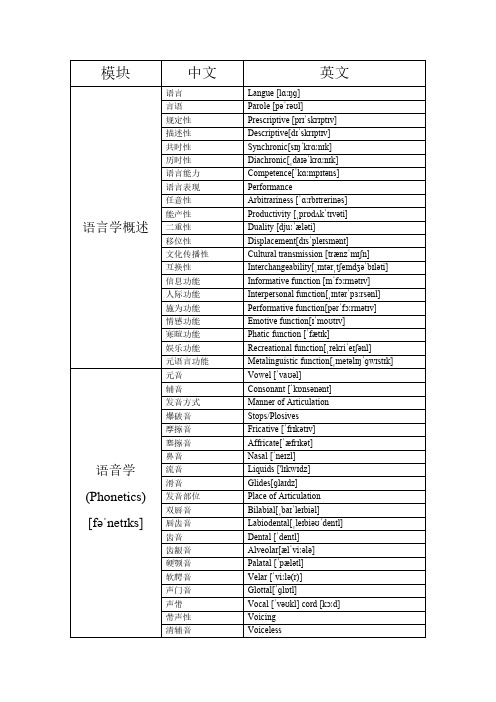
模块中文英文语言学概述语言Langue[lɑːŋɡ]言语Parole[pəˈrəʊl]规定性Prescriptive[prɪˈskrɪptɪv]描述性Descriptive[dɪˈskrɪptɪv]共时性Synchronic[sɪŋˈkrɑːnɪk]历时性Diachronic[ˌdaɪəˈkrɑːnɪk]语言能力Competence[ˈkɑːmpɪtəns]语言表现Performance任意性Arbitrariness[ˈɑːrbɪtrerinəs]能产性Productivity[ˌprɒdʌkˈtɪvəti]二重性Duality[djuːˈæləti]移位性Displacement[dɪsˈpleɪsmənt]文化传播性Cultural transmission[trænzˈmɪʃn]互换性Interchangeability[ˌɪntərˌtʃeɪndʒəˈbɪləti]信息功能Informative function[ɪnˈfɔːrmətɪv]人际功能Interpersonal function[ˌɪntərˈpɜːrsənl]施为功能Performative function[pərˈfɔːrmətɪv]情感功能Emotive function[ɪˈmoʊtɪv]寒暄功能Phatic function[ˈfætɪk]娱乐功能Recreational function[ˌrekriˈeɪʃənl]元语言功能Metalinguistic function[ˌmetəlɪŋˈɡwɪstɪk]语音学(Phonetics) [fəˈnetɪks]元音Vowel[ˈvaʊəl]辅音Consonant[ˈkɒnsənənt]发音方式Manner of Articulation爆破音Stops/Plosives摩擦音Fricative[ˈfrɪkətɪv]塞擦音Affricate[ˈæfrɪkət]鼻音Nasal[ˈneɪzl]流音Liquids['lɪkwɪdz]滑音Glides[ɡlaɪdz]发音部位Place of Articulation双唇音Bilabial[ˌbaɪˈleɪbiəl]唇齿音Labiodental[ˌleɪbiəʊˈdentl]齿音Dental[ˈdentl]齿龈音Alveolar[ælˈviːələ]硬颚音Palatal[ˈpælətl]软腭音Velar[ˈviːlə(r)]声门音Glottal[ˈɡlɒtl]声带Vocal[ˈvəʊkl]cord[kɔːd]带声性Voicing清辅音Voiceless浊辅音Voiced[vɔɪst]音系学(Phonology) [fəˈnɒlədʒi]音素Phone音位Phoneme[ˈfəʊniːm]音位变体Allophone[ˈæləfəʊn]互补分布Complementary[ˌkɒmplɪˈmentri]distribution 最小对立体Minimal pairs音位对立Phonemic[fəʊˈniːmɪk]contrast形态学(Morphology) [mɔːˈfɒlədʒi]词素Morphemes[ˈmɔːfiːmz]自由词素Free Morphemes粘着词素Bound Morphemes词根Root词缀Affix[əˈfɪks,ˈæfɪks]前缀Prefix[ˈpriːfɪks]后缀Suffix[ˈsʌfɪks]词干Stem屈折词缀Inflectional[ɪnˈflɛkʃən(ə)l]Affix派生词缀Derivational[ˌdɛrɪˈveɪʃən(ə)l]Affix 复合法Compound派生法Derivation发明法Invention混成法Blending['blendɪŋ]首字母连写法Initialism[ɪnˈɪʃəlɪzəm]首字母缩略法Acronym[ˈækrənɪm]借词法Borrowing逆构词法Back-formation[fɔːˈmeɪʃn]语义学(Semantics)[sɪˈmæntɪks]同义关系Synonymy[sɪˈnɒnɪmi]方言同义词Dialectal[ˌdaɪ.əˈlek.təl]synonyms[ˈsɪnənɪmz]文体同义词Stylistic[staɪˈlɪstɪk]synonyms情感同义词Emotive synonyms搭配同义词Collocational[ˌkɒləʊˈkeɪʃən(ə)l]synonyms 语义同义词Semantic synonyms反义关系Antonymy[æn‘tɒnɪmɪ]等级反义关系Gradable[ˈɡreɪdəbl]antonymy互补反义关系Complementary antonymy反向反义关系Converse antonymy上下义关系Hyponymy[haɪ'pɒnɪmɪ]上义词Superordinate[ˌsuːpər'ɔːdɪnət]下义词Hyponyms['haɪpəʊnɪm]一词多义Polysemy[pəˈlɪsɪmi]同音/同形异义关系Homonymy[ho'mɑnəmi]同音异义词Homophone[ˈhɒməʊfəʊn]同形异义词Homographs完全同音异义词Complete Homonyms[ˈhɒm.ə.nɪm]蕴含entailment[ɪnˈteɪl.mənt]预设Presuppose[ˌpriːsəˈpəʊz]语用学(Pragmatics) [præɡˈmætɪks]言内行为Locutionary[ləu'kju:ʃənəri]act言外行为Illocutionary[ˌɪləˈkjuːʃəneri]act言后行为Perlocutionary[ˌpɜːrləˈkjuːʃəneri]act直接言语行为Direct speech act间接言语行为Indirect speech act合作原则Cooperative principle数量准则Quantity maxim[ˈmæksɪm]质量准则Quality maxim关系准则Relation maxim方式准则Manner maxim会话含义Conversational implicature[ˈɪmplɪkətʃər]修辞学(Rhetoric)[ˈretərɪk]头韵Alliteration[əˌlɪtəˈreɪʃn]押尾韵End rhyme反韵Reverse rhyme准押韵(类韵)Assonance[ˈæsənəns]拟声Onomatopoeia[ˌɑːnəˌmætəˈpiːə]斯普纳现象Spoonerism[ˈspuːnərɪzəm]明喻Simile暗喻Metaphor转喻(借代)Metonymy[məˈtɑːnəmi]提喻Synecdoche[sɪˈnekdəki]隐喻(典故)Allusion[əˈluːʒn]拟人Personification[pərˌsɑːnɪfɪˈkeɪʃn]夸张Hyperbole[haɪˈpɜːrbəli]矛盾Oxymoron[ˌɑːksɪˈmɔːrɑːn]委婉语Euphemism[ˈjuːfəmɪzəm]反语Irony[ˈaɪrəni]双关Pun移就Transferred epithet[ˈepɪθet]。
- 1、下载文档前请自行甄别文档内容的完整性,平台不提供额外的编辑、内容补充、找答案等附加服务。
- 2、"仅部分预览"的文档,不可在线预览部分如存在完整性等问题,可反馈申请退款(可完整预览的文档不适用该条件!)。
- 3、如文档侵犯您的权益,请联系客服反馈,我们会尽快为您处理(人工客服工作时间:9:00-18:30)。
Discourse analysis, belongs to applied linguistics, came to prominence in translation studies in the 1990s.
Text analysis: normally concentrates on describing the way in which texts are organized( sentence structures, cohesion, etc.
Discourse analysis: looks at the way language communicates meaning and social and power relations.
Register(语域: the style of a piece of writing or speech (colloquial, formal, literary, etc. usually used in particular circumstances.
语域(Register)是语言使用的场合或领域的总称。
英国语言学家韩礼德(M. A. K. Halliday)将语域定义为,语言变体可以按照使用的情况划分为语域。
语言使用的领域的种类很多,例如:新闻广播、演说语言、广告语言、课堂用语、办公用语、家常谈话、与幼童谈话、与外国人谈话、口头自述等。
在不同的领域使用的语言会有不同的语体。
语域的三个社会变量:语场(field),语旨(tenor)和语式(mode)。
具有某种具体用途的语言变体,它与社会或区域(因说话者的不同而异)相对。
使语言行为适应于某一特定活动类型、正式程度等的一种倾向。
语域是由多种情境特征------特别是指语篇语场、语篇方式和语篇基调------相联系的语言特征构成的。
语域是语篇针对特定的交际场合,为达到某一交际目的而产生的一种功能变体,它是多种参数------语篇语场、方式和基调------的综合体现,不只是一种单纯的语篇方式变体。
